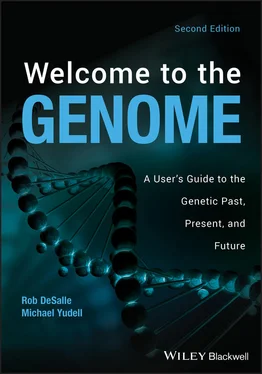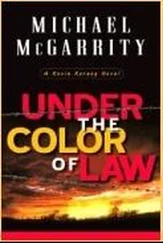The show was very popular despite the occurrence of the 9/11 attack and its aftermath during its run, drawing over half a million visitors. Since its run at the AMNH it was installed in natural history or science museums in Toronto, Canada, Sao Paulo, Brazil, Mexico City, Mexico, and several American cities. As a companion to the show, my colleagues Rob DeSalle and Michael Yudell produced a very popular volume entitled Welcome to the Genome that tells the story of genetics, genomics, and the sequencing of the human genome. These two authors were involved in the development of the exhibition, one as its curator and the other as a content advisor. Their treatment of the topic spanned discussion of Mendel, Darwin, development of molecular biology, and the DNA sequencing technology of the time, as well as delving into the ethical conundrums caused by the capacity to decipher the so‐called stuff of life – DNA. Rob, as a curator at the AMNH, has led the museum’s effort to broaden its scope of research and education and demonstrate our capacity to connect with dynamic fields like genomics and with applications like human health.
Now, nearly 20 years later, Rob and Michael have produced a second edition, demonstrating that many things have changed since their first version, and at the same time some remain the same. The sequencing technology has developed to the point where the $1000 human genome is possible and where we are now getting sequences of the microbes that live in and on the body called the microbiome. The tree of life, a major interest here at the AMNH that Rob and Mike delve into in great detail in this book, has also benefited from the development of genomic technology, which has improved our understanding of human evolution, both deep in the past and more recent. It is now possible to sequence the genomes of Neanderthals and long dead Homo sapiens specimens, giving science an unprecedented view of our past history. Ethical issues have also emerged as the technology gets faster and cheaper. Development of new gene editing technologies opens the way for germline editing of humans and raises many questions about the application of this technology. This new edition by Rob and Michael will provide the kind of modern, current, and thought‐provoking information that is in keeping with one of the most important scientific revolutions of our time.
As a natural history museum, the AMNH strives to educate the public about science in the natural world and to teach the public about how science is accomplished, who scientists are, and what the science might mean to their future. This edition of Welcome to the Genome is a wonderful extension of that initial effort in education that the AMNH launched nearly two decades ago.
Michael J. Novacek
Provost of Science
American Museum of Natural History
Second editions test the foundations of longstanding collaboration, especially when a book’s research and writing goes on far longer that either collaborator had predicted (or, for that matter, hoped). But here we are. Welcome to the Genome (the second edition) is a book way too many years in the making. The slow pace at which we wrote, however, actually turned out to be a good thing. The science evolved. As did our own perspectives on genomics. And if you look at the tone of the two editions of the book, our evolution on the genomic revolution is clear. We went from “Hey, this is awesome and it will change the world” (first edition) to “The science and technology of genomics are amazing, especially as they impact basic science. But, as far as the genome’s impact on our collective health and wellbeing, well, way too much hype” (second edition).
This second edition, built on the foundation of the first, owes so much to the many librarians and archivists who guided us through both editions. We also remain thankful to the many members of our team who made this book possible. At the American Museum of Natural History, Maron Waxman, formerly Special Publications Director, who is now enjoying retirement, was a dedicated editor, staunch advocate, and good friend, and remains the reason why we wrote this book in the first place.
The staff of the American Museum of Natural History’s photo studio, including Denis Finnin and Craig Chesek, helped us put together the images seen in both the first and second editions. Some of these images began as components of the Museum’s exhibition “The Genomic Revolution,” an exhibit that ran at the Museum and then nationally from 2002 to 2010. We are grateful to the Museum’s exhibition team, including Vice President for Exhibitions, David Harvey, and exhibition designer, Tim Nessen.
We remain grateful for the inspiration and contributions from the writers and researchers in the Museum’s Exhibition Department, who played an important role shaping this book, especially the first edition. Lauri Halderman, Karen de Seve, and Martin Schwabacher were the writers for “The Genomic Revolution.” Some of the passages and case studies in both editions were originally researched and written by the exhibition’s writing team. We especially relied on their approach and writing in Chapter 10, which looks at genetically modified organisms. And we must also thank and recognize Dr. Yael Wyner for her efforts in guiding the exhibition’s content and thus for her intellectual contributions to this book.
The entire staff of the Museum’s library and archives deserves our special thanks for helping us with this project. Finally, we want to thank Museum President, Ellen Futter, and Museum Provost, Michael Novacek, whose continued support and commitment to public education about the genome project helped get both volumes of this book off the ground.
Two colleagues read the manuscript in its entirety. Dr. Holly Tabor, Associate Professor of Medicine at Stanford University, and David Randle from the American Museum of Natural History offered detailed comments on the book. Suzanne Grossman, my former research assistant here at Drexel, spent almost a year working with Rob and I completing the book, editing the text, gaining photo and image permissions, and making sure we got the damn thing done. We are so grateful to Suzanne! Thank you! We are grateful for the additional research assistance provided along the way by Katia Duey and Jaime Earnest at Drexel.
Finally, we are very grateful for the patience and ongoing support of Antony Sami, Priya Subbrayal, and the entire team at John Wiley & Sons, who helped shepherd this second edition to completion.
INTRODUCTION: WELCOME BACK TO THE GENOME
Every one of the trillions of cells in your body contains DNA—from the blood cells that course through your veins to the nerve cells in your brain to the hair follicle cells that line your scalp. The tightly coiled DNA in a single cell, 6 feet long and just one molecule wide when unraveled, packs more than 3 billion bits of information. This complete set of information is your genome. The approximately 20,000 genes in your genome (a figure that has been revised down significantly since we wrote the first edition of this book more than a decade ago), interacting with each other and with your environment, help shape the development of a new human being and are constantly at work instructing our bodies to create new cells, digest food, fend off disease, and store thoughts. Genes and DNA capture our imagination because of their impact on why we are the way we are. But how much control do genes and DNA really have over our bodies and our behavior? And to what extent will our changing understanding of the human genome change who we are and how we see the world? Are our genes our destiny? Are our genomes our fate?
Such questions captured our imagination in the midst of the genomic revolution—the international multi‐billion‐dollar effort to sequence, interpret, and exploit the human genetic code. It was believed that a map of our genome would offer boundless potential to sequence, interpret, and then exploit the information contained in the genetic code. The excitement over the potential to improve our health—to stave off disease, to apply genomic tools to feed the world’s growing population, to save species on the brink of extinction—captured the imaginations of scientists around the globe in the opening decade of the genomic revolution.
Читать дальше












